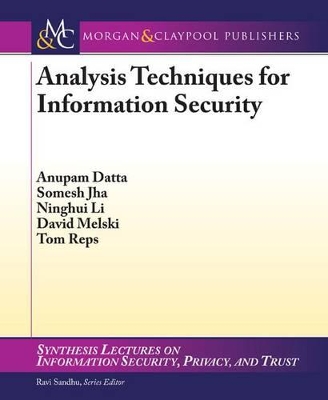Synthesis Lectures on Information Security, Privacy, and Trust
2 total works
Analysis Techniques for Information Security
by Anupam Datta, Somesh Jha, Ninghui Li, and David Melski
Published 28 April 2010
Increasingly our critical infrastructures are reliant on computers. We see examples of such infrastructures in several domains, including medical, power, telecommunications, and finance. Although automation has advantages, increased reliance on computers exposes our critical infrastructures to a wider variety and higher likelihood of accidental failures and malicious attacks. Disruption of services caused by such undesired events can have catastrophic effects, such as disruption of essential services and huge financial losses. The increased reliance of critical services on our cyberinfrastructure and the dire consequences of security breaches have highlighted the importance of information security. Authorization, security protocols, and software security are three central areas in security in which there have been significant advances in developing systematic foundations and analysis methods that work for practical systems. This book provides an introduction to this work, covering representative approaches, illustrated by examples, and providing pointers to additional work in the area.
Over the last decade, differential privacy (DP) has emerged as the de facto standard privacy notion for research in privacy-preserving data analysis and publishing. The DP notion offers strong privacy guarantee and has been applied to many data analysis tasks.
This Synthesis Lecture is the first of two volumes on differential privacy. This lecture differs from the existing books and surveys on differential privacy in that we take an approach balancing theory and practice. We focus on empirical accuracy performances of algorithms rather than asymptotic accuracy guarantees. At the same time, we try to explain why these algorithms have those empirical accuracy performances. We also take a balanced approach regarding the semantic meanings of differential privacy, explaining both its strong guarantees and its limitations.
We start by inspecting the definition and basic properties of DP, and the main primitives for achieving DP. Then, we give a detailed discussion on the the semantic privacy guarantee provided by DP and the caveats when applying DP. Next, we review the state of the art mechanisms for publishing histograms for low-dimensional datasets, mechanisms for conducting machine learning tasks such as classification, regression, and clustering, and mechanisms for publishing information to answer marginal queries for high-dimensional datasets. Finally, we explain the sparse vector technique, including the many errors that have been made in the literature using it.
The planned Volume 2 will cover usage of DP in other settings, including high-dimensional datasets, graph datasets, local setting, location privacy, and so on. We will also discuss various relaxations of DP.
This Synthesis Lecture is the first of two volumes on differential privacy. This lecture differs from the existing books and surveys on differential privacy in that we take an approach balancing theory and practice. We focus on empirical accuracy performances of algorithms rather than asymptotic accuracy guarantees. At the same time, we try to explain why these algorithms have those empirical accuracy performances. We also take a balanced approach regarding the semantic meanings of differential privacy, explaining both its strong guarantees and its limitations.
We start by inspecting the definition and basic properties of DP, and the main primitives for achieving DP. Then, we give a detailed discussion on the the semantic privacy guarantee provided by DP and the caveats when applying DP. Next, we review the state of the art mechanisms for publishing histograms for low-dimensional datasets, mechanisms for conducting machine learning tasks such as classification, regression, and clustering, and mechanisms for publishing information to answer marginal queries for high-dimensional datasets. Finally, we explain the sparse vector technique, including the many errors that have been made in the literature using it.
The planned Volume 2 will cover usage of DP in other settings, including high-dimensional datasets, graph datasets, local setting, location privacy, and so on. We will also discuss various relaxations of DP.

